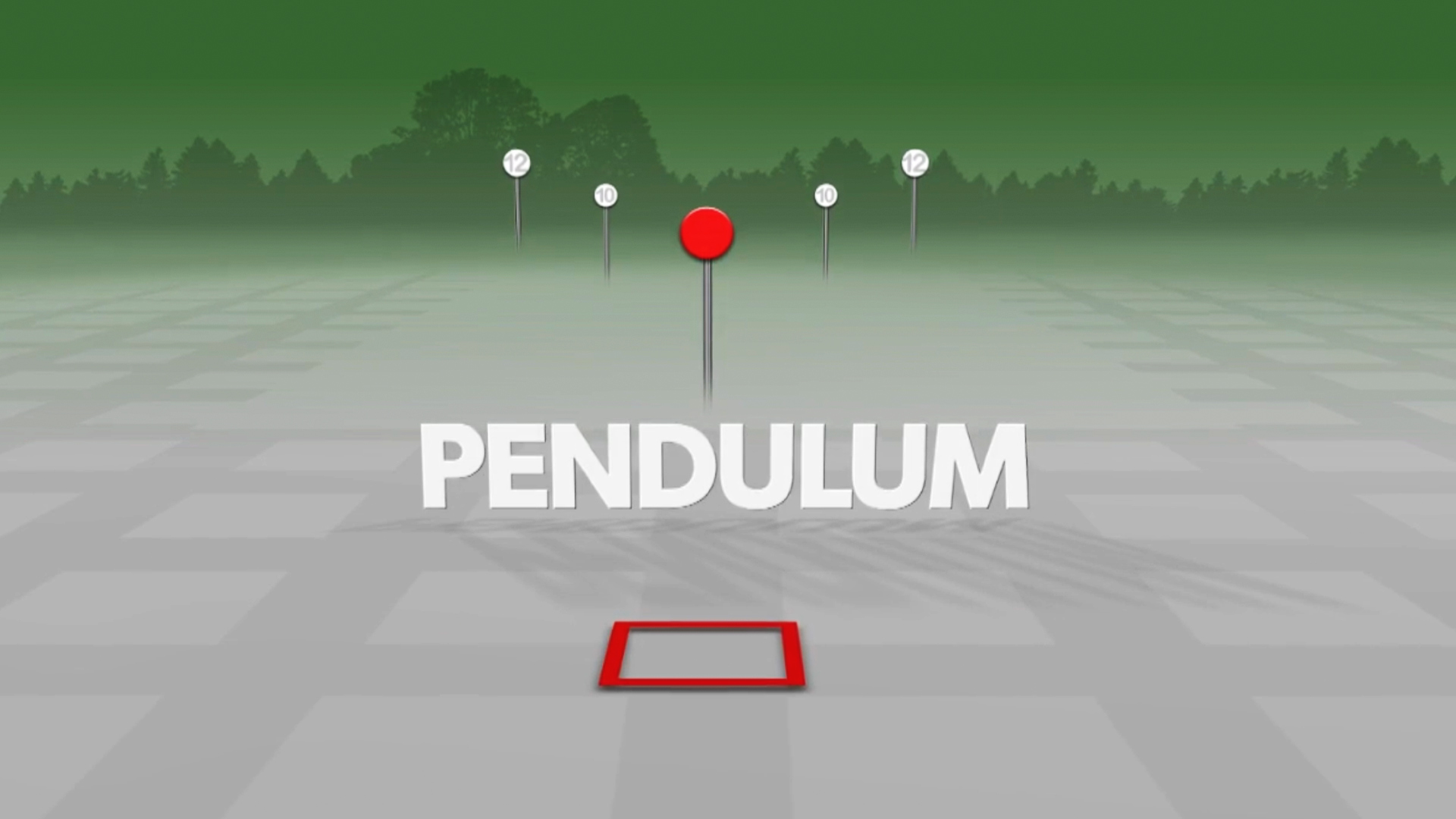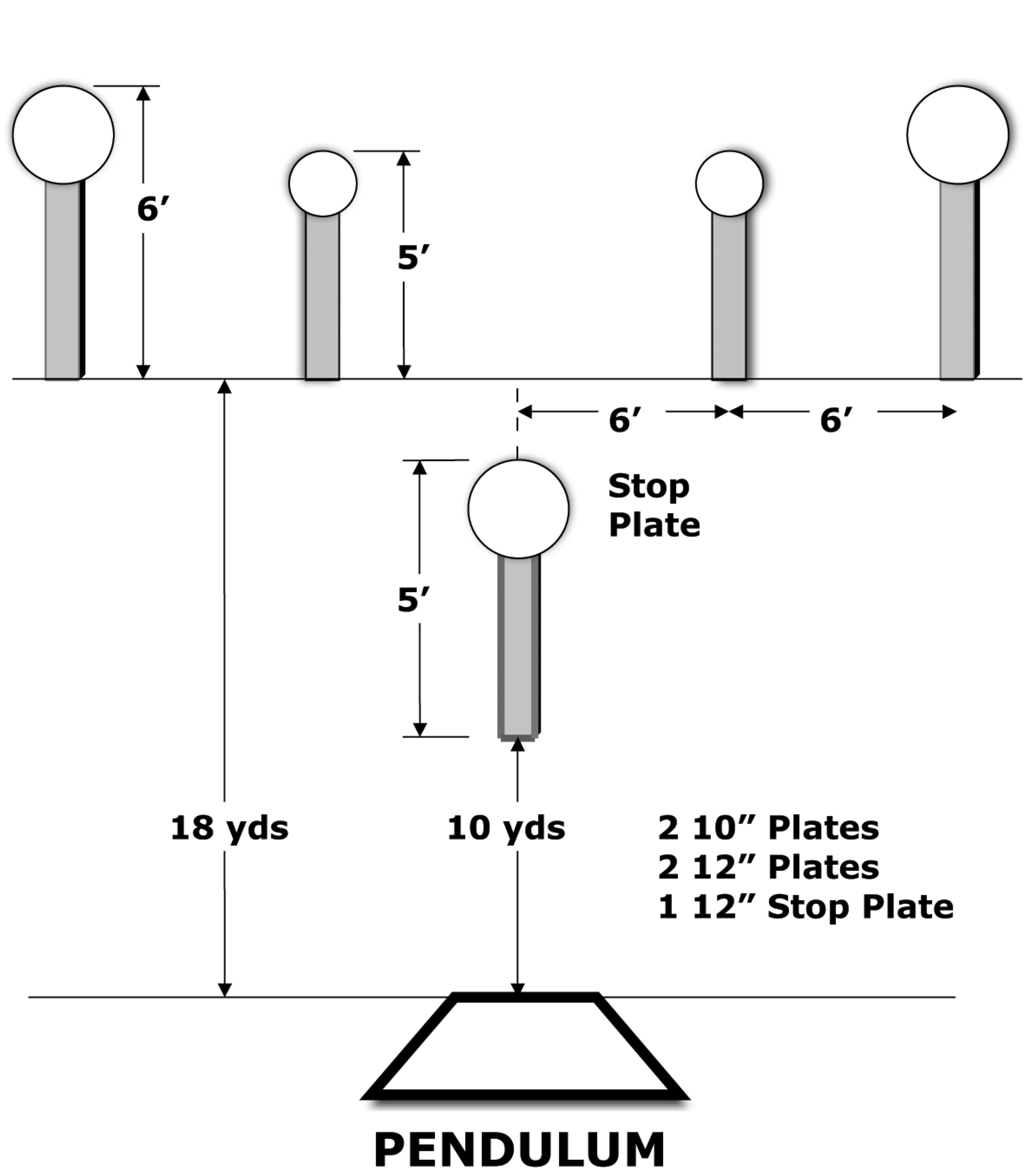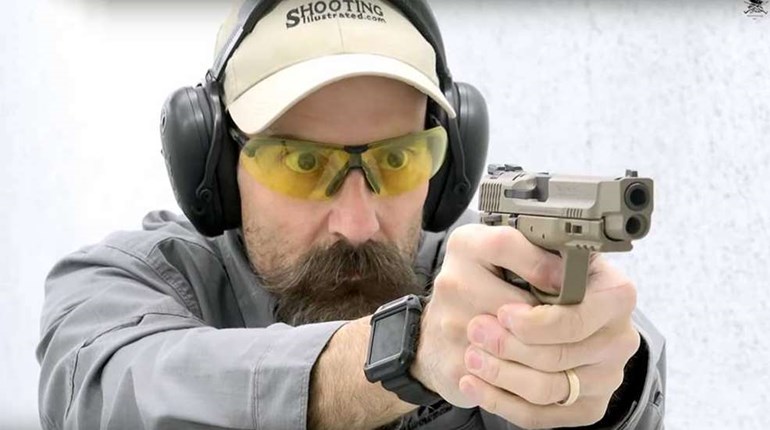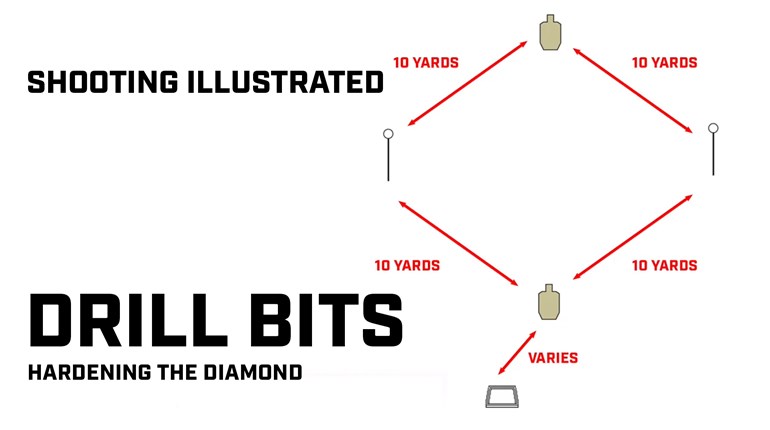
The reason many Steel Challenge shooters struggle with Pendulum is threefold:
- Target distance—all targets are at 18 yards.
- Target size—there are two 10-inch plates.
- This is the only stage where the targets are at different heights and you must change your aimpoint between targets.
When you combine all these factors, it’s easy to see why, particularly for newer shooters, that Pendulum can seem to be quite challenging. However, for the most part, shooters tend to make this stage harder than it really is—so let’s try to break it down and see if we can make it a little less daunting. (Note: I don’t consider this stage to be the most difficult; I reserve that for the Steel Challenge stage we’ll cover last in this series, Outer Limits.)
Here’s the secret to shooting this stage well. You should just pick one side or the other as your first target (No. 1 or No. 5), then simply shoot the stage straight across and finish off with a single reversal transition to the stop plate. That’s it. Don’t make this stage harder than it needs to be by picking some convoluted order, just shoot it straight across so you only need to execute one reversal transition.

I’ve seen all manner of shooting orders when it comes to this particular stage, as folks try to eliminate the supposed impact of the different heights of the plates. Actually, this should not figure into your thinking at all. Yes, you’ll have to adjust your aim point as you transition from No. 1 to No. 2 and then again from No. 4 to No. 5. However, given the lateral distance between plates, this turns out to be just a minor adjustment, and you have plenty of time to do this smoothly as you move between the plates.
It’s true that the 10-inch, 18-yard plates are the most difficult targets you’ll encounter in the match, because they present the smallest target area to the shooter. However, this is offset somewhat by the fact that they are all at the same distance in a nice straight line, with the stop plate being an easy 12-inch plate at 10 yards in the exact middle of the stage.
Shooters psych themselves out on this stage all the time. They are easy to spot as your squad is approaching this stage since you’ll hear them say something like, “Oh, I hate this stage,” or, “I always have trouble with this one.” Well, guess what? They’re already defeated before they ever fire a single shot, having convinced themselves that they don’t shoot this stage very well. What do you think will happen when they shoot the stage? Nine times out of 10, they will shoot it poorly just like they believed they would.
Don’t be this shooter. If this is a stage that you currently struggle with, then make it a training emphasis until you do shoot it well. Early on, I was one of these shooters and could hear myself mentally cringing any time I approached this stage at a match. I finally made it a special training goal to learn to shoot this stage well no matter what it took.
The proof that I had accomplished this came at a Steel Challenge state championship back in 2015. Day one of the match found my squad starting on Pendulum and looking at the shooting order it appeared I’d be shooting last. After the stage brief was completed by the Range Officer, he announced the shooting order: “Ken Verderame is first up, followed by …” Yikes! Not exactly what I was expecting to hear, but I didn’t panic, I just gathered up my gun and as I was walking to the shooting box I just repeated to myself, “I own this stage,” and proceeded to shoot one of my best match stage times ever at that point.
One of the other reasons for simply shooting this stage straight across is that it minimizes the transition distance for the two most difficult targets (No. 2 and No. 3), and it again allows you to accelerate towards the stop plate as you come off plate No. 5 (or No. 1) and transition to the 12-inch, 10-yard stop plate, which is always a good thing.
One thing to watch out for on this stage is the so-called “trap plate” which will be either plate No. 4 or No. 1, depending on which direction you are shooting. The trap plate on a stage refers to one particular plate in a shooting order that can cause you a lot of trouble if you are not paying particular attention to it. It will usually come in the form of a miss and subsequent make-up shot or worse, an uncalled miss and a three-second penalty.
On Pendulum, plate No. 4 (or No. 1) is a trap plate because many shooters will try to rush by this last plate on the way to the stop plate and miss it. Missed plates, and the accompanying make-up shots, are always painful from a time standpoint, but it’s particularly bad when they fall on a reversal transition like here with Pendulum. Do not fall into the trap that your conscious mind can play on you that you are shooting too slow and therefore need to “make up time” getting to the stop plate.
The best way to shoot this stage is to get into a cadence and simply shoot every plate and transition at the same speed, and try not to either slow down or speed up between each plate. Adopting this shooting strategy ensures the trap plate becomes a non-issue. As we’ll see later, this type of shooting is also the key to shooting Five To Go really well.
A final word about make-up shots with respect to this stage—in almost all cases, it is always faster to complete shooting your first four plates in whatever order you have selected, and only then return to a plate that you have missed, versus trying to stop and immediately reverse directions to make up a shot. This is particularly true on Pendulum where you have to deal with both different sizes of plates and different plate heights. If you miss a plate, don’t panic; just complete shooting all four plates, then go back for the makeup shot. Shooting in this manner should result in the least amount of additional time.
So if Pendulum has been one of your difficult Steel Challenge stages to master, try using some of the techniques presented here, and with some diligent training you should be able to turn it from a match liability to an asset. And as always, remember, slowing down is never the right answer, never; you need to learn to see faster.
Article from the January/February 2024 issue of USPSA’s magazine.
About the author: Ken Verderame is a three-division Steel Challenge Grand Master, 2018 Florida State Champion and creator of the only Steel Challenge dry-fire training system on the market (www.steelshootbanners.com). Check out his two books: “The Game Within The Game: Mastering The Steel Challenge Mental Game” and “Do You Feel The Need For Speed.” Both are available at Amazon Books. Additionally, check out his podcast, “The Ultimate Steel Shooter Show.”


































